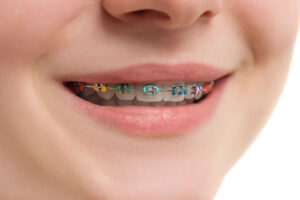Braces and Children Orthodontics
What is Orthodontics?

Orthodontics is a type of treatment that helps to straighten or align your teeth using a selected type of braces.
With Orthodontics Treatment (or Braces treatment), brushing your teeth becomes easier with less food substances stuck between previously misaligned teeth. This improves your facial profile and also offers you a more confident smile.
TYPES OF ORTHODONTICS TREATMENT

Braces are made of translucent material that blends with the natural colour of teeth. The aim of braces is to straighten and align teeth – this helps with improving facial profiles and re-creating a beautiful smile.
1. Metal Braces

Also known as traditional braces, metal braces are one of the most common types of braces in Singapore. They consist of metal brackets, modules and an archwire that is fixed to the front of your teeth.
Metal braces have been known to be the relatively affordable option, as compared to Invisalign or self-ligating braces. With the ability to treat various types of malocclusion such as overbite, overcrowding, or crossbite, traditional braces are great if you are looking for a reliable and budget-friendly option. Additionally, you can customise the colour of the modules as you wish.
FAQS
How long does traditional braces treatment last?
While this is highly dependent on the condition of your malocclusion, traditional metal braces treatment typically take at least one year to complete.
Is it painful to have metal braces on?
Initially, it is common to feel discomfort and soreness, especially after tightening the braces. However, after the next couple of appointments, the discomfort level usually decreases.
2. Ceramic Braces

While these braces may carry a similar size and shape as metal braces, the material used is the trait that sets ceramic braces apart from their metal counterparts. Ceramic braces use clear brackets that blend better with the natural colour of teeth.
Ceramic braces treatment is perfect for patients who do not want their braces to look too conspicuous. As the ceramic material is typically more brittle than traditional braces, they are made to be slightly bigger to increase its sturdiness.
FAQS
Do ceramic braces get stained easily?
While the white brackets of ceramic braces do not get stained easily, the clear elastic bands which connect the brackets to the archwire can get stained often. One key tip to avoid staining is to rinse your mouth after each time you eat.
Am I suited for ceramic braces?
Ceramic braces are suited for teenagers or adults who are more cautious with what they eat. On the other hand, children do not typically choose ceramic braces as they find difficulty maintaining them and keeping them clear.
3.Damon Braces (Self-Ligating Braces)

Damon braces, otherwise known as self-ligating braces, are fitted in the same way as metal braces. But, these self-ligating braces do not involve regular tightening and adjustment, making it the preferred braces that offers less discomfort.
Damon braces (self-ligating braces) utilises a slide mechanism – the wires are smoothly attached to brackets to move naturally with your teeth as they realign. The slide mechanism is a cutting-edge technology that aligns crooked teeth while sustaining a more natural smile for patients. Without the use of metal wires (used in traditional braces to secure the archwire), Damon braces (self-ligating braces) treatment might be slower but offers more comfort.
FAQS
Is Damon braces (self-ligating braces) treatment longer because the regular tightening is not involved?
The Damon braces (self-ligating braces) treatment duration is highly dependent on an individual’s case complexity. Your doctor would be best in advising an estimated duration for your Damon braces treatment.
Without metal wires, is less maintenance of Damon braces (self-ligating braces) needed?
Although less food and plaque are trapped without metal wires, regular oral hygiene should still be followed, including daily flossing habits, with Damon braces (self-ligating braces) treatment.
4.Kids Orthodontics

While braces treatment is most common among the teenage group in Singapore, anyone can be treated orthodontically – even those as young as 7 years of age! In fact, orthodontic treatments prove to be most successful when carried out during the active growth years and when children’s teeth are still growing. Several orthodontic problems that prove to be harder to correct when older are: overbite, underbite, crossbite, overcrowding, finger sucking and other oral habits.
Besides braces, several appliances can serve as early intervention orthodontics. Devices such as functional appliances and palate expanders are also used to correct teeth and jaw misalignment, as well as other orthodontic issues. Yet, not all appliances are appropriately suited for early intervention.
FAQS
When is a good age for my child to begin wearing braces?
How urgent braces treatment is needed would depend on the condition of the child’s teeth. Kids orthodontics treatment is usually done when children are between 7-12 years old. This is because it’s better to correct any orthodontic problems before the complete set of permanent teeth grow out.
FAQs

1. What is the average cost of braces in Singapore?
The average cost of braces in Singapore can vary from one clinic to another. The price is dependent on a couple of factors, particularly, the choice of orthodontic material, the treatment complexity and the orthodontist’s level of expertise. That being said, metal braces are usually the most affordable choice, while Damon braces has the highest price point.
Fortunately, most clinics in Singapore provide instalment plans, breaking up the total treatment cost into affordable monthly fees. If you are facing budget concerns, do drop us a call to discuss the instalment policies and find one to suit your budget best.
2. What is the duration for orthodontics (braces) treatment?
The duration depends on the individual patient’s teeth and their maintenance of oral hygiene. Typically, the average length of braces treatment is 2.5 to 3.5 years.
3. Are ulcers common with the wearing of braces?
It is extremely common to sustain ulcers during your orthodontics treatment.
Consider applying wax on the metal attachment in order to smoothen the movement between the metal bracket and your mouth.
4. How often do I need to visit the dentist to adjust braces?
It is advisable to arrange a monthly appointment to check on the progress of your treatment.
5. What should I do if my bracket falls out?
Should the bracket fall out, it’s best to keep it first. Then, you can either arrange for a dental appointment to fix back the bracket or inform the dentist during your next retie visit.
6. What can I do if the wire/bracket causes me discomfort?
Should the wire/bracket cause you any form of discomfort, give the clinic a call to arrange for an appointment. They can help you examine your mouth and provide you with the wax to smoothen the area.
If the power chain has broken or the wire has detached from the bracket, it’s best to make an appointment and get the problem rectified.
![[:en]Braces[:]](https://luminousdentalgroup.com/wp-content/uploads/2018/03/services_5.jpg)
Make An Appointment
Open from Mondays to Sundays
Closed on public holidays
Please call 6538 2001 or fill in our online appointment form.

